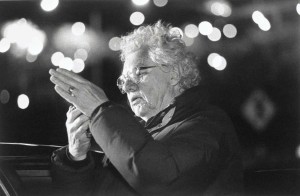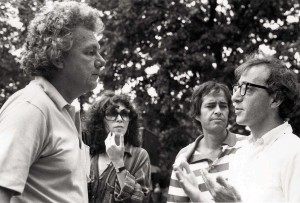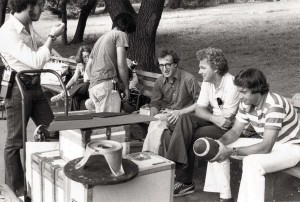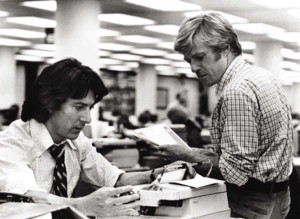
His career has so many high points, it resembles the Himalayas. Peaks that especially stand out include The Godfather and The Godfather: Parts II and III for director Francis Ford Coppola; Woody Allen masterpieces like Manhattan, Annie Hall and Zelig; Klute and All the President’s Men with Alan Pakula; and for director James Bridges, a series of films highlighted by The Paper Chase.
Most of the other movies Willis filmed have not just stood the test of time but gained in critical stature over the years. Examples include Little Murders, directed by Alan Arkin; Up the Sandbox helmed by Irvin Kershner; and Pennies from Heaven, directed by Herb Ross.
Willis has invariably worked on films with innovative directors and strong scripts that allowed him to use his skills to the fullest. Plus, the actors in the movies include some of the best talent to have graced the screen in the last three decades: Jane Fonda, Donald Sutherland, Paul Newman, Robert de Niro, Al Pacino, Barbra Streisand, Diane Keaton, Robert Redford, Dustin Hoffman, Stacy Keach, Steve Martin, Meryl Streep – and Marlon Brando in his last great star turn in the first Godfather.
When it comes to awards, Willis has had his share of kudos. But maybe because he worked outside the Hollywood mainstream, mostly in New York, he never received an Academy Award, although he did get nominated twice for an Oscar – for best cinematography for Zelig and The Godfather: Part III. Eventually he got an honorary career Oscar in 2010. And he received the Lifetime Achievement Award from the American Society of Cinematographers in 1995.

Willis was born in New York in 1931, just as the Depression was beginning to bite. His parents had been dancers in Broadway and road shows – it was touch and go as far as money was concerned – but his father landed a long-term job in the makeup department at Warner Bros. in Brooklyn. Willis would occasionally accompany him to work and he’d hang out at the studio. “All of the people in our lives had something to do with movies or some form of show business, but my childhood, thanks to my mother, was very normal,” he says.
The family moved to Manhasset, Long Island, where Willis’ favorite activity was going to the movies at a nearby theater. “My father made friends with the manager, so I got in for nothing,” he recalls. “It was a warm and comfortable place and I loved it.” He became interested in photography as a hobby in his early teens. But his first work was as an actor, doing summer stock for a few seasons. “I also did some lighting and designed a few sets,” he recalls.
 After his parents divorced he moved to Greenwich Village with his father where his interest in photography reasserted itself. “I spent all the time I had taking pictures. I built a darkroom in the basement of the carriage house we were living in. I learned a lot about photography, at my father’s expense.”
After his parents divorced he moved to Greenwich Village with his father where his interest in photography reasserted itself. “I spent all the time I had taking pictures. I built a darkroom in the basement of the carriage house we were living in. I learned a lot about photography, at my father’s expense.”
During the Korean War he enlisted and wound up in the Air Force Photographic & Charting Service in a motion picture unit. “It was serendipity,” he declares. “I spent all four years learning everything I could about making movies.” After being discharged he returned to New York where, with the help of some friends, he got into the cameramen’s union. “Faced with the real thing, I realized I was dumber than dirt and needed to learn everything at a whole new level,” he muses.
Dave Quaid, a DP, helped him find work on company documentaries and commercials. “It was a tough climb up – coal mines, steel mills, anything industrial, and you could easily get killed. Quaid was a good teacher, and technically I was learning a great deal,” he observes. “As I look back, everything good that ever happened to me, happened because of another person. Everyone was very generous.”
Working on documentaries taught Willis “how to get a lot out of a shoot without doing a whole lot technically. You learn to eliminate as opposed to adding. Not too many people understand that. Much of it has to do with how you perceive things. Two people can look at the same thing, but they don’t necessarily ‘see’ the same thing. Documentaries taught me to remove, not add.”
In the ’50s commercials provided a lot of work on the East Coast. The occasional feature would come into New York “and some of us would jump on that for second-camera work. I still had a ways to go. I had a lot to learn technically,” he notes

He started to get hired as a camera operator on commercial work, and some companies where he had worked as an assistant hired him as a DP. Then lightning struck. “One day I got a call to send a reel to someone who was going to shoot a movie called End of the Road,” he remembers. “It changed my life, and it changed my family’s life. It was my first feature film as a DP.”
Willis made a strong impression and suddenly was working nonstop, doing seven films in three years. “My transition into features was very easy,” he notes. “I worked with free thinkers – people who loved film. I did what I thought was right, and I never worried about what other people thought – with the exception of the directors; and they provided an environment that would make it easy to think outside the box. It changed my life because I met a new, wonderful group of people who didn’t look at things in the same old way.”
No two pictures were alike. “I really don’t know how my style developed, except that I never did anything simply to be different – that’s a pointless mindset,” says Willis. “I just did what I thought was appropriate. Why you do something is more important than how. I would always figure out what to do, and why. That always led me to how. Even though I developed certain technical thinking that I liked, I would generally apply it differently on each film. You know, let the punishment fit the crime. Most of what I did was based on selectivity. You can do something in one cut or in 10 cuts; use one light or 20 lights. It’s really a point of view. In my case, I prefer things minimized. I also prefer definition. What it finally boils down to is taste.”
In 1972, Willis hooked up with Pakula for Klute, the first of six films he would do with the director. “Klute was shot in New York, where Alan wanted to do it. I worked and lived in New York, and was getting a good reputation, and I was relatively new. I think all those things appealed to Alan. He called, and we met in a bar on the West Side. We drank our way through the meeting and got along quite well. Alan was very supportive throughout the shoot. Warner Bros. had never quite seen anything mounted on the screen this way: full, rich imagery with very selective framing. To me, it was the normal way to do things. But it made them nervous. Luckily, Alan had a very difficult time making up his mind in the editorial process so time ran out. As a result, the picture was printed as designed – and it was never changed.” Pakula died in an auto accident in 1988. “Alan was very bright, he had great taste,” says Willis. “I miss him.”
When Willis was approached to shoot The Godfather, he almost passed on the project. “It seemed very chaotic to me. At any rate, it smoothed out – at least until we started shooting.” Willis confirms the many stories of how tumultuous the experience of making the first of the three Godfather films turned out to be. “Shooting this movie was like trying to serve a sit-down dinner on the deck of the Titanic. But the conflicts between Francis and myself usually involved ‘how to’ stuff. Francis had a whole other set of problems dealing with Paramount. I give him a great deal of credit for not sinking to the bottom of management hell. Francis wrote and directed one of the better films ever made.
“What Francis and I worked out together was to mount The Godfather in a tableau fashion (subsequently the other two films fell into line as well). That meant no zoom lenses, no helicopters, no contemporary film devices. I think you get a better retrospective feeling on period films done this way.”
But Coppola he says had nothing to do with the lighting and color structure of the movie. “This was something I formulated,” he notes. “And I didn’t come up with the color application until about a day before we started shooting. The lighting design came about because of Marlon’s make-up, which required overhead lighting. But it had to be applied to the whole film and work for everything.” The color stitched the films together. An example of this is the period work in Part II. “I changed the quality of the visuals, the lighting, the exposures. However, the color remained the same. To do it any other way would have pulled the audience in and out of the movie every time we made a retrospective cut.“
As far as the look of The Godfather, this was a story that didn’t need to be fluffed up. “Quite the opposite, you don’t have to embellish cement,” You just have to decide where to stand and watch. To my mind, the idea was to be visually very ‘street,’ of the moment. But it wasn’t real. You have to put a certain distance between the audience and what they’re watching, especially in a period piece. Finally, it had to feel mythic.”
“I can’t really tell anybody how to do this,” he adds. “It’s something that comes out of you. If anything evolved out of this movie, and other films I shot in that period, it was that it made it easier for other filmmakers to work at some other interpretive level. And many have since then.”
Willis first teamed with Woody Allen in 1975 on Annie Hall. “My maturity in films began with my association with Gordon Willis,” Allen has said. The period with Allen, encompassing eight films, “was like working with your hands in your pockets. There was very little stress, it was like a stroll in the park, so to speak,” says Willis. “It was a real cinematic partnership. I think Woody probably got it right one night at dinner. Someone asked about our collaborative process. His answer was, ‘I think we both hate the same things.’
“The truth is “we both embraced the same things, so there weren’t a lot of discussions regarding point of view,” he says, adding: “Woody would give me the pages (in my case, the whole script), define what he liked or wanted, and I would make suggestions about how to shoot it. Once we agreed, I would set the shots, he’d look and say fine or not fine. If something wasn’t working it usually meant, one of us was doing too much. I think we both feel less is better than more.”
A supreme example of that minimalism is the scene in Manhattan at the New York Planetarium where the characters played by Woody Allen and Diane Keaton are barely glimpsed – much of the time the screen is just black. “I think some things are much funnier or have more dramatic impact based on what you hear as opposed to what you see – or ‘now you see it, now you don’t,’ he states. “That can be very funny – or scary – depending on what movie you’re doing. The other thing I did with Woody was to block out long dialogue scenes so they played in one piece with no cuts.”
In the opening scene in Annie Hall, the characters are talking but start from a distance and finally move into a close-up. “You have to structure those so they’re visually arresting, help the actors, and are fun to watch” Willis notes. “Woody found this approach very helpful in playing comedy. He liked it, understood it, and was able to do it very well.”
Four of the films that Willis did with Allen were in black and white: Manhattan, Stardust Memories, Broadway Danny Rose and Zelig. “Black and white was easy for me in the sense that’s what I was exposed to early on, while I was learning my craft,” he says. “To me, color’s a burden. You constantly have to deal with it. The audience has to deal with it. You can’t be arbitrary. As far as lighting is concerned, I generally deal with them both the same way. I think my love for black and white came from watching the great collage of movies that came out of the majors in the late ’30s, ’40s and ’50s. I learned a lot about structure there as well.”
Willis describes his style in Manhattan, the romantic comedy that was also Allen’s valentine to New York City: “I wouldn’t say my style is naturalistic. I would say it’s reconstructed reality that embellishes what is already there. In the case of Manhattan, it’s romantic reality. You can make the same thing ugly or beautiful, just by choosing what you shoot. It was the choices we made that put the magic in Manhattan. Woody and I both see New York as a black and white town, and I love shooting wide-screen anamorphic. Put the two together and look in the right direction, and you get Manhattan.”
Willis got his first Oscar nomination for Zelig, which cleverly melded historic newsreels with new footage. And it presaged some of the visual effects techniques in use today on much more elaborate films. Assembling the film was “a game,” says Willis. “It was fun and easy in one sense, because there were no visual-continuity problems” he adds.
Standard Panavision camera gear was used to shoot and mounted with some older uncoated lenses. “The period look came from how I exposed the negative and what light I chose to do it in – most of the shooting was underexposed, then duped in various ways,” says Willis.
“We went through a lot of footage prior to shooting, and I had to match whatever we cross-cut with that,” he says. “There were, I think, three matte shots. These were bluescreen. Placing the actors on older backgrounds became a bit tricky because I had to guess about what the original focal lengths were. It was kind of a laboratory nightmare. The sound tracks were actually done with old mics. The undercranking in the film was about 18 frames per second.” His bottom-line assessment is that Zelig was “a very interesting, but tedious film – I’m happy it worked out so well.”
These days he’s living the life of Riley on Cape Cod with his wife, Helen. He has two daughters and a son, Gordon Jr., who works as a commercial DP. And he has five grandchildren. “I’m always taking pictures, but professionally I’m done,” he says. “You know what they say – life is uncertain. So I had my dessert first. It was awfully good.”
Finally, what would he like to be remembered for? “The elegance of simplicity,” he responds.





